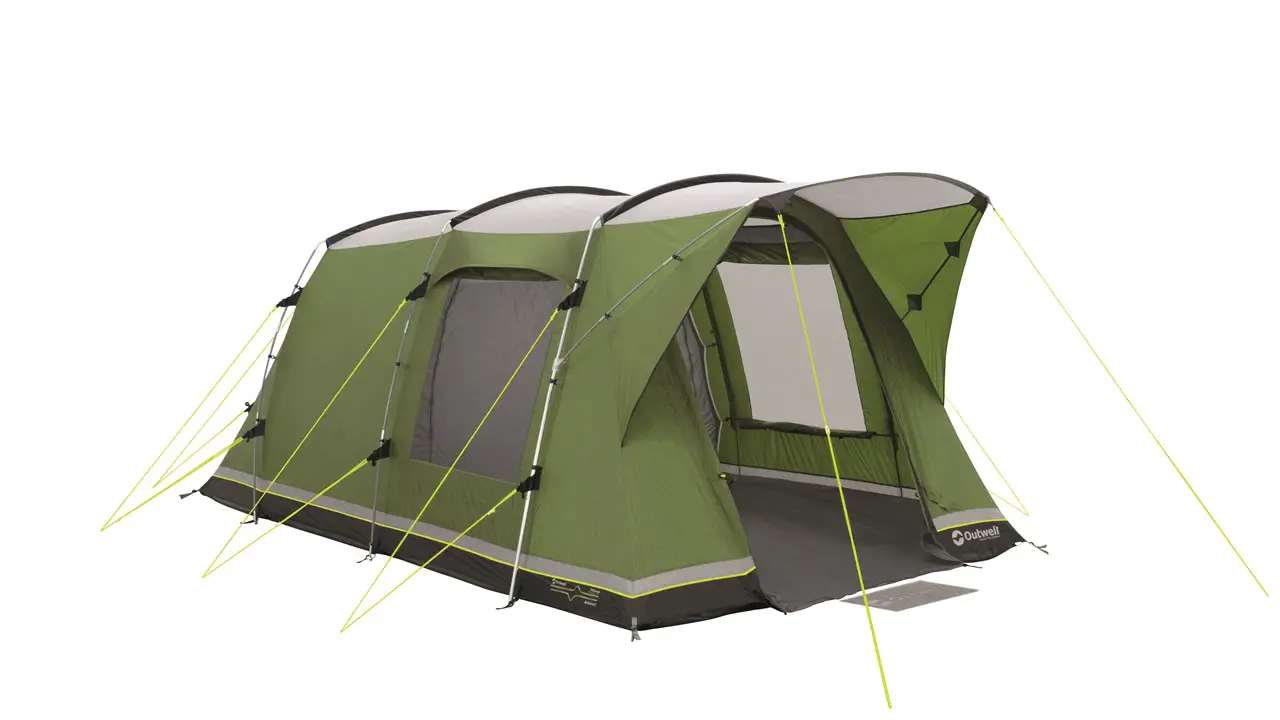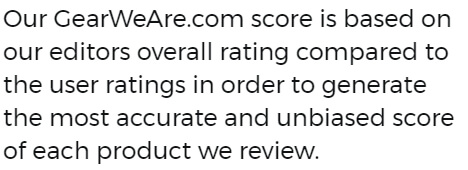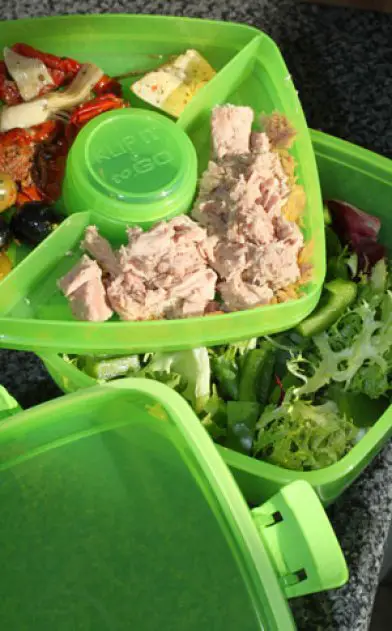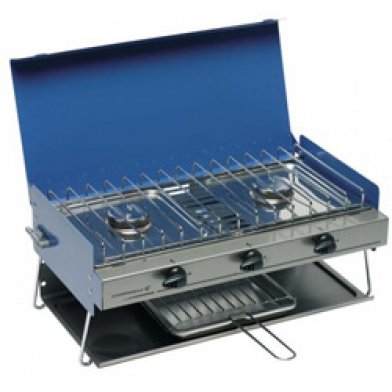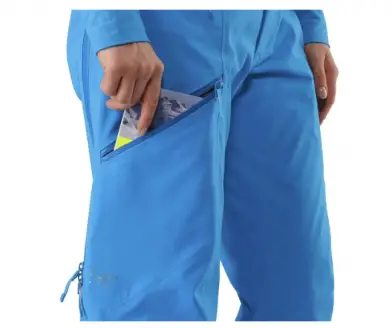Outwell Birdland Tent
SUMMARY: Brilliant. The huge sealed porch, massive windows and flyscreen door make a few niggly issues entirely forgivable, and I'm pretty confident the baggy bit at the back wouldn't have been so bad if it wasn't so windy when we first put it up. The Outwell Birdland is now our tent of choice.
Editor's Pros & Cons
Pros
- Fantastic window views
- Great construction quality
- Spacious interior
Cons
- Some issues with peg strength
in-depth review
Moniker aside, all-in-all this is a great tent with some excellent features. A lot of thought has gone into the Birdland, and it shows.
It’s a three-man affair, held up by three poles and plugged into the ground with a mixture of metal and plastic (black and dayglo) pegs. The poles themselves – two reinforced fiberglass and the third being lightweight steel – are pretty easy to use because the amount of fabric they need to be fed through is minimal, making them much more manageable than your average common-or-garden tent. They can also be strapped to the tent with Velcro for extra stability.
The four heavy duty metal pegs anchor the corners using reinforced fabric loops, but as I discovered when we first pitched this you need to be careful with the mallet because if a loop rests partly over the top of the peg as you wallop it’ll start fraying immediately.
The plastic pegs are also heavy duty but not only are there no spares, if you hit an underground rock with one the point bends and it suffers a stress fracture near the top, rendering it fit for the bin. We buggered two of ours straight away. Normal skinny metal pegs can be straightened and manhandled to an extent, but not these. Outwell plugs them as an ‘Easy Pegging System’ but I’m not convinced at all.
Now Mrs Muz, who is Chief Tent Putter-Upperer, and I were at a major disadvantage when we first pitched this at the Sonisphere festival recently. It was blowing a gale. Literally. Tents around us were disintegrating before our very eyes and many others were heading back to the car park unaccompanied, leaving only cases of Fosters to mark the spot. ‘Struggle’ just doesn’t cover it.
As a result we discovered what may or may not be the Alan’s only real fault – the back, at ground level, doesn’t peg out other than at the corners – there’s no loop at the bottom/middle to keep things taut. This meant that as the wind was blowing straight at the back of the tent the outer, below where the guyline pulled it taut, forced itself inwards because there was nothing to hold it back… kind of like when I suck my substantial gut in when trying to impress the ladies. Hopefully, this pic will give you an idea (note the pooled rainwater around the bottom).
Once the wind died down we found that the Birdland could have been pulled forward more from the front, tightening the fabric more at the back, but I don’t think this would have solved the problem entirely. It didn’t really affect the inside of the tent because the inner fabric of the sleeping quarters is far enough away from the outer, but the movement of the external shell occasionally allowed a tension toggle to pop off between the inner and outer, leaving the inner a wee bit loose. Not a biggie by any means and easily sorted, but still a niggle.
Speaking of wind, apparently the Alan – sorry, Birdland – is designed to withstand up to force nine (54mph). It performed admirably on that first Sonisphere day and didn’t once come close to taking off, despite its baggy bottom.
Inside is where the Birdland comes into its own and becomes the best tent we’ve ever used.
Once zipped up it is totally sealed from the outside world in terms of beasties and snakes and stuff. The impressive 10,000mm hydrostatic head groundsheet (the outer is a decent 4,000mm) is stitched to the outer in what Outwell calls a ‘bathtub’ design, completely enclosing the contents – including the porch area.
The sleeping quarters are pretty standard and although cosy for three, there’s a decent amount of room for two, a couple of rucksacks and a couple of piles of assorted clothes. There are good-sized pockets stitched to the inner on both left and right and a few hanging loops for lights and whatnot. When unzipped the O-shaped door can be bundled into a pocket on the inside, tucking the whole thing completely out of the way. Nice touch.
A double inflatable bed inserted so your heads are at the door makes things a little tight, so taller campers like me (I’m 6’ 2”) might want to turn the bed sideways and sacrifice a little bit of room.
But the porch area is the pièce de résistance. First of all it’s huge – at least as big as that on our four-man Eurohike Stowe, meaning there’s plenty of room for four or five people to sit comfortably, and I can stand up straight in it – bonus!
To the left and right are huge windows, almost from floor to ceiling and very wide, the covers of which roll down rather than up, making them less fiddly. The large door has two great features – not only does the outer door have another huge window to open up the entire panoramic porch when all the covers are off, but it also has a full-size flyscreen which means you can have the outer door rolled open in warm weather and still sit inside without being pestered by pterodactyls and things buzzing in your ears. I love it.
A few other things about the Birdland. There is a handy vertical column of storage pockets on the outside of the sleeping pod as well as plenty of storage room around the sides between the inner and outer. Below the main door is a short horizontal zip for a power cable to be fed through, with Velcro loops around the inside wall to keep it tucked out of the way.
Vents are nice and long and proved very effective during its windy inaugural outing. I can imagine that they’re pretty standard fayre under ordinary circumstances with less airflow, but when coupled with the mesh door, ventilation is the best I’ve come across.
When packed away the whole thing is a bit big and weighty but that’s no big deal when you take into account all of the Birdland’s plus points.
I highly recommend this tent, despite it’s four hammers, and even the included repair kit has come in handy. Here’s a word of advice – don’t pitch your tent on broken glass. It’ll go straight through the groundsheet, inner and outer when you come to pack it up *sad face*.
SUMMARY: Brilliant. The huge sealed porch, massive windows and flyscreen door make a few niggly issues entirely forgivable, and I’m pretty confident the baggy bit at the back wouldn’t have been so bad if it wasn’t so windy when we first put it up. The Outwell Birdland is now our tent of choice.
It’s a three-man affair, held up by three poles and plugged into the ground with a mixture of metal and plastic (black and dayglo) pegs. The poles themselves – two reinforced fiberglass and the third being lightweight steel – are pretty easy to use because the amount of fabric they need to be fed through is minimal, making them much more manageable than your average common-or-garden tent. They can also be strapped to the tent with Velcro for extra stability.
The four heavy duty metal pegs anchor the corners using reinforced fabric loops, but as I discovered when we first pitched this you need to be careful with the mallet because if a loop rests partly over the top of the peg as you wallop it’ll start fraying immediately.
The plastic pegs are also heavy duty but not only are there no spares, if you hit an underground rock with one the point bends and it suffers a stress fracture near the top, rendering it fit for the bin. We buggered two of ours straight away. Normal skinny metal pegs can be straightened and manhandled to an extent, but not these. Outwell plugs them as an ‘Easy Pegging System’ but I’m not convinced at all.
Now Mrs Muz, who is Chief Tent Putter-Upperer, and I were at a major disadvantage when we first pitched this at the Sonisphere festival recently. It was blowing a gale. Literally. Tents around us were disintegrating before our very eyes and many others were heading back to the car park unaccompanied, leaving only cases of Fosters to mark the spot. ‘Struggle’ just doesn’t cover it.
As a result we discovered what may or may not be the Alan’s only real fault – the back, at ground level, doesn’t peg out other than at the corners – there’s no loop at the bottom/middle to keep things taut. This meant that as the wind was blowing straight at the back of the tent the outer, below where the guyline pulled it taut, forced itself inwards because there was nothing to hold it back… kind of like when I suck my substantial gut in when trying to impress the ladies. Hopefully, this pic will give you an idea (note the pooled rainwater around the bottom).
Once the wind died down we found that the Birdland could have been pulled forward more from the front, tightening the fabric more at the back, but I don’t think this would have solved the problem entirely. It didn’t really affect the inside of the tent because the inner fabric of the sleeping quarters is far enough away from the outer, but the movement of the external shell occasionally allowed a tension toggle to pop off between the inner and outer, leaving the inner a wee bit loose. Not a biggie by any means and easily sorted, but still a niggle.
Speaking of wind, apparently the Alan – sorry, Birdland – is designed to withstand up to force nine (54mph). It performed admirably on that first Sonisphere day and didn’t once come close to taking off, despite its baggy bottom.
Inside is where the Birdland comes into its own and becomes the best tent we’ve ever used.
Once zipped up it is totally sealed from the outside world in terms of beasties and snakes and stuff. The impressive 10,000mm hydrostatic head groundsheet (the outer is a decent 4,000mm) is stitched to the outer in what Outwell calls a ‘bathtub’ design, completely enclosing the contents – including the porch area.
The sleeping quarters are pretty standard and although cosy for three, there’s a decent amount of room for two, a couple of rucksacks and a couple of piles of assorted clothes. There are good-sized pockets stitched to the inner on both left and right and a few hanging loops for lights and whatnot. When unzipped the O-shaped door can be bundled into a pocket on the inside, tucking the whole thing completely out of the way. Nice touch.
A double inflatable bed inserted so your heads are at the door makes things a little tight, so taller campers like me (I’m 6’ 2”) might want to turn the bed sideways and sacrifice a little bit of room.
But the porch area is the pièce de résistance. First of all it’s huge – at least as big as that on our four-man Eurohike Stowe, meaning there’s plenty of room for four or five people to sit comfortably, and I can stand up straight in it – bonus!
To the left and right are huge windows, almost from floor to ceiling and very wide, the covers of which roll down rather than up, making them less fiddly. The large door has two great features – not only does the outer door have another huge window to open up the entire panoramic porch when all the covers are off, but it also has a full-size flyscreen which means you can have the outer door rolled open in warm weather and still sit inside without being pestered by pterodactyls and things buzzing in your ears. I love it.
A few other things about the Birdland. There is a handy vertical column of storage pockets on the outside of the sleeping pod as well as plenty of storage room around the sides between the inner and outer. Below the main door is a short horizontal zip for a power cable to be fed through, with Velcro loops around the inside wall to keep it tucked out of the way.
Vents are nice and long and proved very effective during its windy inaugural outing. I can imagine that they’re pretty standard fayre under ordinary circumstances with less airflow, but when coupled with the mesh door, ventilation is the best I’ve come across.
When packed away the whole thing is a bit big and weighty but that’s no big deal when you take into account all of the Birdland’s plus points.
I highly recommend this tent, despite it’s four hammers, and even the included repair kit has come in handy. Here’s a word of advice – don’t pitch your tent on broken glass. It’ll go straight through the groundsheet, inner and outer when you come to pack it up *sad face*.
SUMMARY: Brilliant. The huge sealed porch, massive windows and flyscreen door make a few niggly issues entirely forgivable, and I’m pretty confident the baggy bit at the back wouldn’t have been so bad if it wasn’t so windy when we first put it up. The Outwell Birdland is now our tent of choice.





